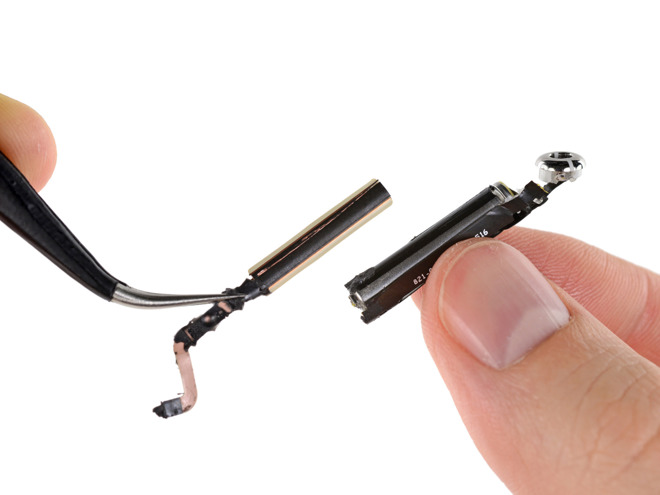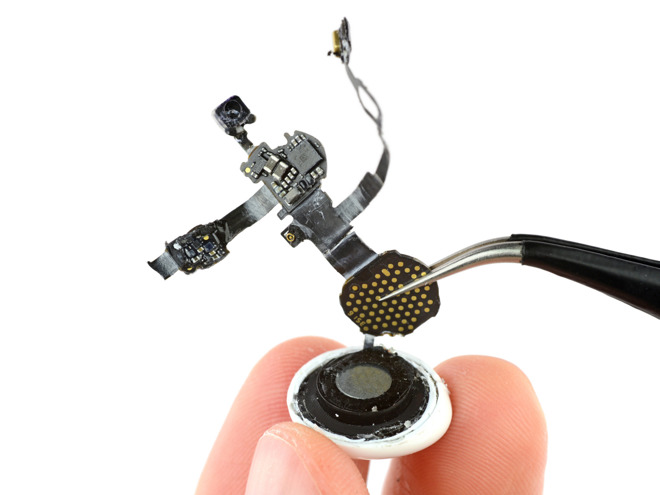Teardown destroys Apple's irreparable AirPods, revealing tiny circuitry held together by g...
With Apple's AirPods now in the hands of customers, a subsequent teardown of the wearable wireless ear buds has transpired, unsurprisingly discovering that the diminutive technology is essentially impossible to repair or even recycle.

The components experts at iFixit conducted the dissection of the AirPods, discovering a very tiny 93-milliwatt-hour battery inside the stem of each earpiece. That's just over 1 percent of the charge capacity of Apple's iPhone 7.
Inside the separate charging case, Apple has packed in a still-tiny 3.81V 1.52Wh lithium polymer battery, offering about 16 times the capacity of the ones found in the AirPods themselves. Based on capacity, the case should provide users with up to eight recharges before it needs to be recharged itself, through a Lightning port on the bottom.

Taking apart the AirPods rendered them completely broken, as the in-ear accessories are held together entirely by glue. The charging case fared even worse, as it had to be cut open and destroyed in order to access the internal components.
The clever design of the AirPods packs multiple components into a small space. The in-ear portion features not only the speaker, but also infrared proximity sensors to detect when it's placed in the user's ear canal.
The stems, too, feature antennas surrounding the batteries, allowing for improved reception. And the metal tips at the end of the stems both cover the microphones and act as contact points for charging when placed into the case.

In a bit of speculation, iFixit did an X-ray scan of the charging case and found that an STMicroelectronics ARM chip within has what the solutions provider called "quality issues" with its solder joints. They suggested that this could have been the culprit for delays that caused the accessory to miss its October launch. However, as of yet, there have been no other such indications that the quality of the AirPods case has been an issue.
Other chips inside the AirPods include:

The components experts at iFixit conducted the dissection of the AirPods, discovering a very tiny 93-milliwatt-hour battery inside the stem of each earpiece. That's just over 1 percent of the charge capacity of Apple's iPhone 7.
Inside the separate charging case, Apple has packed in a still-tiny 3.81V 1.52Wh lithium polymer battery, offering about 16 times the capacity of the ones found in the AirPods themselves. Based on capacity, the case should provide users with up to eight recharges before it needs to be recharged itself, through a Lightning port on the bottom.

Taking apart the AirPods rendered them completely broken, as the in-ear accessories are held together entirely by glue. The charging case fared even worse, as it had to be cut open and destroyed in order to access the internal components.
The clever design of the AirPods packs multiple components into a small space. The in-ear portion features not only the speaker, but also infrared proximity sensors to detect when it's placed in the user's ear canal.
The stems, too, feature antennas surrounding the batteries, allowing for improved reception. And the metal tips at the end of the stems both cover the microphones and act as contact points for charging when placed into the case.

In a bit of speculation, iFixit did an X-ray scan of the charging case and found that an STMicroelectronics ARM chip within has what the solutions provider called "quality issues" with its solder joints. They suggested that this could have been the culprit for delays that caused the accessory to miss its October launch. However, as of yet, there have been no other such indications that the quality of the AirPods case has been an issue.
Other chips inside the AirPods include:
- An Apple-branded chip identified as 343500130, believed to be the W1 Bluetooth component
- Cypress CY8C4146FN programmable system on a chip
- Maxim 98730EWJ low-power stereo audio codec
- Texas Instruments TPS743
- NXP 1610A3 charging integrated circuit
- Texas Instruments BQ24232 power management integrated circuit

Comments
They don't actually care "repairability" from the environmental perspective, nor can they make an educated guess on the recyclability of a product.
So if you want an idea of how iFixit run their business: head over to their repair forums, there is no shortage of experienced technicians who don't have nice things to say about them.
Meanwhile the replacement part here is to simply order an airpod direct from apple, it's cheaper, quicker and will actually pass QA.
It's disappointing for many of use that Apple has reduced the user upgrade experience to near zero. And now, a failed component will more often than not mean Apple replacing the entire mobo instead of the bad component(s).
But that it means Apple has a failing business model is just not true.
And with all the hardware finessed into those plastic cases, they still manage to come up with an elegant design — well, one that seems a bit weird at first sight, but one we'll probably get used to. Anyway, they look like they're worth $160 to me. Waiting for mine to arrive to hear how they perform.
I find the "destroyed" components to be fascinating. It's amazing how much stuff Apple can pack into such a small device. I can't wait to see the knockoffs opened up and how poor their manufacturing is. No way would I put anything this complex in my ears from another manufacturer. Think about all the power adapters that burn up.
Apple isn't the only one making hard (or impossible) to repair devices. When I've had my brakes repaired on my cars, they always replace the brake calipers instead of wasting their time trying to repair them. I usually get rebuilt calipers but not all calipers are rebuilt, some end up in the recycle pile. Repair time cost money, in many cases more than it takes to build a new device. It all depends on the device that needs repairing. Something small like the AirPods are probably manufactured in 10-30 minutes. It would take that much time just to get past the repair front desk before any repair is even attempted. Think about all those plastic PCs. Most of those are consumables, not really worth repairing. Sure, you can try and update/upgrade them but for the money, they really aren't worth it. Yes, this is a sad state in our economy where we throw away more things than we fix but the only alternative is to try and over build products so they don't break. This, of course, means a much higher initial cost and much heavier product.
One last thing: iFixit sells plastic tools that are meant to be destroyed instead of destroying the product being worked on. I guess I give those tools a 0 out of 10 because they are useless after using a few times. (yes, a bit of sarcasm but sometimes iFixit needs to think about how repairable items should be and not immediately discount a fantastic design.)
There are plenty of wired earbuds and even wired headsets that can't be repaired -- nearly all of them.
Let's face it: some items simply aren't meant to be repaired. If Airpods were designed to be fixed then they would be four times their current size and weight. They would have ear clips to hold their massive mass in place.